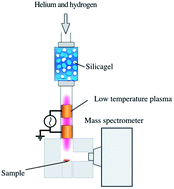Development of an ionization method using hydrogenated plasma for mass analysis of surface adhesive compounds
Abstract
Currently, atmospheric plasmas are applied to the desorption and ionization of surface adhesive materials for rapid and highly sensitive analysis. One widely used chemical ionization method applies protons generated from atmospheric water molecules to a desorbed sample; however, a detailed study of the ionization mechanism has not been addressed thus far. Therefore, this paper proposes an ionization method that adds a small, optimized amount of hydrogen to the helium plasma for generating protons in the sample ionization source. Using this technique, mass spectrometry was performed on the sample surface deposits of 2-isopropylpyridine and 4-isopropylaniline. The hydrogen flow rate was optimized to the addition ratio of 2%, and the lowest limit of detection achieved is 0.1 and 42 pmol for 2-isopropylpyridine and 4-isopropylaniline, respectively. By optimizing the hydrogen addition flow rate, the optimum number of protons for sample ionization was attained, and it became possible to realize control of proton content in the sample, irrespective of humidity and surrounding environmental factors during mass spectrometry.



 Please wait while we load your content...
Please wait while we load your content...